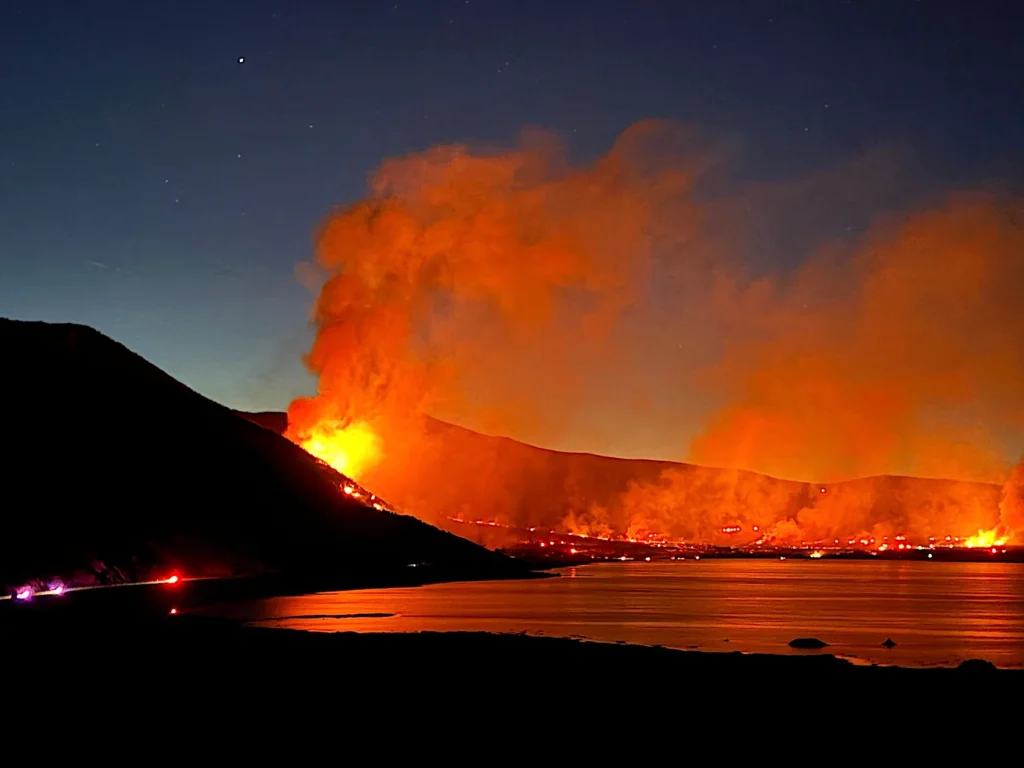1. What Sparked the Lake Fire 2025 and How Did It Escalate?
Around 4 p.m., the Silverwood Lake State Recreation Area in San Bernardino County, Southern California, experienced an unplanned lake fire. What started as a relatively minor brush fire quickly turned into a fast-moving blaze. Fueled by dry vegetation, steep terrain, and gusting winds, the fire expanded to nearly 480 acres within just a few hours.
Its rapid spread came as no surprise to fire officials, who had been warning for weeks about the dangerous fire conditions created by an unusually dry winter. This incident served as yet another example of how quickly the fire season in California can go from quiet to catastrophic.
2. How Rapidly Did the Fire Grow?
In its first few moments, the Lake Fire burst to life with an unexpected and fierce intensity. Within the first few hours, what began as a small flare-up had engulfed hundreds of acres. The fire exhibited what is known as “critical rate of spread” behavior—spreading faster than firefighting resources could contain.
Strong winds, low humidity, and dense dry brush created a perfect storm, making suppression efforts extremely difficult. The fire’s rapid growth prompted immediate emergency evacuations in the surrounding recreational zones.
3. Massive Evacuation Effort: Visitors Rescued from Beach Area
Perhaps the most dramatic moment in the early hours of the fire was the evacuation of approximately 100 individuals who had been spending the afternoon at Cleghorn Beach. Many were caught off guard in casual beachwear with no idea that a wildfire was moving in their direction.
As smoke and flames crept closer, some evacuees had to be transported via jet skis and private boats across the water. Park rangers coordinated with bystanders and first responders to ensure everyone made it to safety. Road barricades prevented some families from driving away, leaving them temporarily trapped in parking lots.
4. Containment Status and Ongoing Firefighting Efforts
By the following morning, the fire had scorched nearly 485 acres but was reportedly 10 to 15 percent contained. Fire officials stated that forward progress had stopped, which marked a crucial turning point in the battle against the blaze.
Over 500 personnel, dozens of engines, aircraft, and bulldozers were deployed to fight the fire. Crews worked through the night to establish control lines and monitor hot spots. The multi-agency response included local fire departments, state firefighting units, and federal resources.
5. Weather Conditions Continue to Complicate Efforts
Weather has played a significant role in both the fire’s rapid spread and the challenges facing firefighters. On the day the fire ignited, winds surged with bursts reaching speeds of 25 miles per hour. Forecasts indicated even stronger gusts exceeding 30 miles per hour in the following days.
Low humidity and rising temperatures were additional concerns. Such conditions dry out even the greenest vegetation, turning it into potential fuel. Fire behavior experts warned that even minor changes in wind direction could pose serious risks to containment efforts and firefighter safety.
6. Infrastructure Disruptions and Community Impact
The fire’s impact extended beyond the flames. Several major roads were shut down, including parts of Highway 173 and Highway 138. Law enforcement agencies set up checkpoints to prevent unauthorized access while allowing emergency personnel and evacuees to move safely.
Silverwood Lake State Recreation Area, a popular destination for families and outdoor enthusiasts, was forced to close its gates temporarily. All existing reservations were canceled, and the park is expected to remain shut until fire officials declare it safe to reopen.
Additionally, high-voltage power lines in the area remain under threat. Utility companies are closely monitoring the situation to prevent power disruptions or additional hazards.
7. California’s Escalating Wildfire Crisis

The Lake Fire is not an isolated event. California and other Western states are experiencing a wider wildfire issue, of which this is a symptom. A lack of significant rainfall during the winter months created tinderbox conditions, making even small ignition sources potentially catastrophic.
This year alone, fire departments across the state have responded to hundreds of wildfires. Experts warn that climate-related factors, such as prolonged drought and extreme heatwaves, are contributing to longer and more destructive fire seasons.
In recent years, the financial and human cost of wildfires in California has surged. Dozens of people have died and billions of dollars have been damaged. Public safety officials continue to stress the importance of early evacuation, community preparedness, and investment in fire prevention measures.
Timeline of Key Events
| Date | Event Description |
| June 28 | Fire ignites near Silverwood Lake at 4 p.m. |
| June 28 | Fire spreads to 480 acres by 8 p.m. |
| June 28 | 100 visitors rescued from beach and parking areas |
| June 29 | 10–15% containment achieved |
| June 30 | Winds forecasted to exceed 30 mph, posing new risks |
Safety Guidelines for Nearby Residents and Visitors
If you live in or plan to visit an area near Silverwood Lake, it is essential to take the following precautions:
- Stay informed by signing up for official fire alerts.
- Avoid travel near affected highways unless absolutely necessary.
- Have an evacuation plan ready, including supplies, documents, and emergency contacts.
- Clear defensible space around your home by removing flammable debris.
- Follow instructions from local authorities and do not return to evacuated areas until approved.
Conclusion
The Lake Fire is a sobering reminder of how vulnerable even recreational areas can be during wildfire season. Quick coordination between emergency crews and local residents helped avert a larger tragedy, but the conditions that sparked this fire are still present across the region.
Ongoing monitoring, firefighting, and community cooperation will determine how quickly this fire is fully contained. As summer continues, residents are urged to remain vigilant, informed, and prepared for the unexpected.


